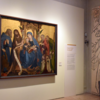The Museo Diocesano Tridentino wins the European Heritage Award / Europa Nostra Award 2021
Europe's most prestigious heritage award

The European Commission and Europa Nostra have just announced the winners of the European Heritage Awards/Europa Nostra Awards 2021, the EU Prize for Cultural Heritage funded by the Europa Creativa programme. The Museo Diocesano Tridentino (Tridentine Diocesan Museum) is one of the winners and will compete for the Grand Prix in the autumn. The prize has been awarded to the Museo Diocesano Tridentino (the only Italian museum selected) in the Education, Training and Awareness-raising category for the exhibition L'invenzione del colpevole. Il 'caso' di Simonino da Trento, dalla propaganda alla storia (Inventing the culprit. The ‘case’ of Simonino da Trento, from propaganda to history).
The 2021 Prize winners were announced during a live online event co-presented by Mariya Gabriel, European Commissioner for Innovation, Research, Culture, Education and Youth, and Hermann Parzinger, Executive President of Europa Nostra. This year, Europe's highest award in the field of heritage was given to 24 projects from 18 European countries. The award winners were selected by independent juries of European experts who assessed the entries submitted by organisations and individuals from 30 European countries.
Heritage supporters and enthusiasts are now encouraged to find out the winners and vote online to decide who will win this year's Public Choice Award. The winner of the Public Choice Award will be announced during the European Heritage Awards ceremony, which will take place in autumn this year. The Grand Prix winners will also be made public on this occasion.
Source: editorial staff
***
The Invention of a Guilty Party, Trento, ITALY
The exhibition The Invention of a Guilty Party: The case of little Simone of Trento from propaganda to history (“L’invenzione del colpevole: Il caso di Simonino da Trento dalla propaganda alla storia”) sheds light on a historical episode that left a deep mark on the history of Trento, Italy. The work admiringly stimulates critical reflection on the construction of a hostile “other”; the spread of intolerant behaviour towards people of differing race, religion or culture, stoked by prejudice and stereotypes; and the power of propaganda and fake news.
The exhibition was organised by Museo Diocesano Tridentino and is based on extensive research in collaboration with the Dipartimento di Lettere e Filosofia, the Facoltà di Giurisprudenza of the University of Trento, the Archivio Diocesano Tridentino and the Fondazione Museo Storico of Trento. The project was funded by the Autonomous Province of Trento, the Fondazione Caritro and the Comune di Trento.
In 1475, Trento was witness to the death of two-year old Simone resulting in the conviction of three Jewish families for ‘ritual murder’ on the basis of confessions obtained under torture and strenghtend by anti-Jewish propaganda created by the Bishop of the period. Simonino da Trento was subsequently worshipped as a martyr well into the mid-20th century.
The re-examination of the court documents in 1965 led to the Church’s abolition of the cult. Since then, the chapels devoted to Simonino da Trento had been closed and iconographical works relating to the cult were stored away from public eye. The Museum has now bravely picked up this historical thread and attached it to the present, aiming to make the public aware of the dangerous re-emergence of racist and anti-Semitic tendencies and pointing to the importance of independent critical thought to combat intolerance.
The Jury praised the great significance of the presentation of the ‘case of Simonino’ within a contemporary framework: “This is a project of great relevance for the contemporary world in that it employs a method to create critical thinking related to historical processes and deconstructs a historical example of fake news. The project, a strong collaboration with many researchers, is not just an exhibition but a process that is ongoing and will continue.”
As part of the exhibition, various teaching materials were prepared for first and second level secondary school pupils, including a walk through the city looking for evidence of the Hebrew Ashkenazi community of Trento alongside the relevant locations to the ‘case of Simonino’. Due to its importance on regional, national and international levels, the ‘case of Simonino’ will be embedded in the permanent display of the Museum.
“This project reveals the creation of fake history and shows the value of critical thinking. It has great relevance in combating fake news and therefore has great relevance for the contemporary world,” noted the Jury.
Source: www.europeanheritageawards.eu
26/05/2021



